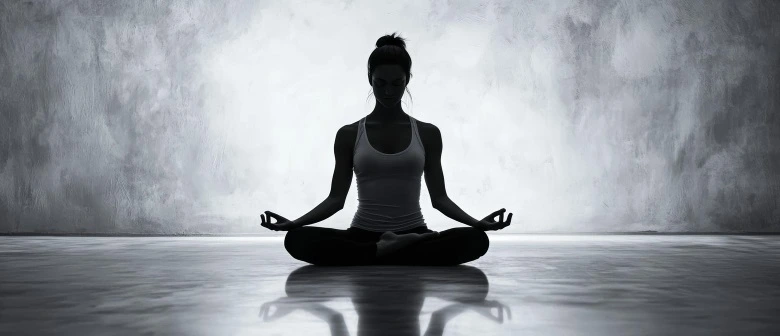Table of Contents
Yoga philosophy, from the Sanskrit word “yoga,” meaning “union”, is one of the six orthodox systems (darshans) of Indian philosophy as described in Patanjali’s Yoga Sutras. This ancient framework aims to unite the mind, body, and spirit to achieve spiritual liberation (moksha) through practice. With over 500 million yogis worldwide and the rise of global online yoga platforms and AI-enhanced meditation tools, yoga philosophy is more relevant than ever. This guide explains the core principles of yoga philosophy, the four paths of yoga, the eight limbs of yoga, and their impact on mental health and stress management, so beginners and experienced yogis can find inner peace and self-realization.
Get Certified, Get Confident! Join Our Yoga Teacher Training Course!
Core Principles of Yoga Philosophy
Yoga philosophy says that the mind, body and spirit are connected, an integrated whole beyond separation. Based on the Samkhya system, which is dualistic between purusha (consciousness) and prakriti (matter), yoga diverges by acknowledging Ishvara, a divine archetype guiding us to liberation. Unlike Samkhya, which is atheist, yoga is theistic, and spiritual freedom through practic
Four Paths of Yoga
1: Which of these is the primary goal of yoga practice?
There are 4 governing forces that represent ‘True Nature’ of our lives. These are Mind, Body, Emotion & Energy.
On the basis of these 4 forces, each person has a different kind of individuality. Hence, ancient sages developed disciplines for each kind of person to achieve the ultimate goal of yoga & we call it 4 paths of yoga.
1.What is Jnana Yoga?
Jnana is Sanskrit for “knowledge or wisdom,” and Jnana Yoga is the path of attaining knowledge of the true nature of reality through the practice of meditation, self-inquiry, and contemplation. Jnana Yoga can be defined as the “awareness of absolute consciousness,” and is a comprehensive practice of self-study (Svadhyaya).
In Jnana yoga, the mind is used to inquire into its own nature and to transcend the mind’s identification with its thoughts and ego. The fundamental goal of Jnana yoga is to become liberated from the illusory world of maya (self-limiting thoughts and perceptions) and to achieve the union of the inner Self (Atman) with the oneness of all life (Brahman). This is achieved by steadfastly practicing the mental techniques of self-questioning, reflection and conscious illumination that are defined in the Four Pillars of Knowledge. Jnana Yoga utilizes a one-pointed meditation on a single question of self-inquiry to remove the veils of illusion created by your concepts, world views, and perceptions. This practice allows you to realize the temporary and illusory nature of maya and to see the oneness of all things.
2.What Is Bhakti Yoga?
It can seem as though the word “yoga” has become synonymous with contortionist poses, usually performed by fit, nondisabled, white bodies in utopian locales, but that is far from the full picture of what this rich tradition has to offer.
The physical postures are just a tiny fraction of the practice. In fact, many styles of yoga don’t involve doing poses at all.
Returning to the root of the word “yoga,” we find “yuj-,” which means “to yoke, bind, or connect.” While there are many lineages of yoga, all with different routes and aims, all styles and schools of yoga share a search for connection to something greater than ourselves.
It could be argued that no style of yoga is more devoted to that search than Bhakti yoga, the yoga of devotion.
Bhakti yoga is often called the yoga of love or the path of devotion.
The word “bhakti” comes from the root “bhaj,” which means “to pray” or “to share.”
While there can be a heavy focus toward specific deities or the Divine, depending on your lineage, many modern scholars and teachers now explain Bhakti yoga much more globally. They consider it the practice of seeking unconditional loving for everyone and everything.
3.What is Karma Yoga?
Karma yoga is one of the four classical schools of yoga alongside Jnana (knowledge or self-study), Bhakti (devotion) and Raja (meditation), each offering a path to moksha (spiritual liberation) and self-realization.
Derived from the Sanskrit term for “action,” both Hindu and Buddhist traditions understand karma to be the sum of a person’s deeds in past, present, and future states of existence. In yoga, karma is known as the path of action, or selfless service towards others. People consider Karma yoga one of the most practical and effective means of spiritual development.
4.What is Raja Yoga
In Sanskrit, the word raja translates as king, chief, or royal. Thus, Raja Yoga is considered to be the best path to attaining the highest state of yoga, samadhi or enlightenment. It refers to both the highest goal of yoga and the meditation practices used to attain this goal. Swami Vivekananda describes this internal meditative practice as a path towards mastering the whole universe. He writes, “Raja-Yoga proposes to start from the internal world, to study internal nature, and through that, control the whole, both internal and external.”
Yoga Teacher Training – Learn from Experienced Instructors! Get Free Demo Here!
Become a Certified Yoga Instructor
Yoga Teacher Training Course by Entri App: Master authentic yoga techniques, earn certification, and build a successful career as a professional yoga instructor.
Join Now!Eight Stages of Yoga
Generally, the Yoga process is described in eight stages (ashtanga-yoga, “eight-membered Yoga”). The first two stages are ethical preparations. They are yama (“restraint”), which denotes abstinence from injury falsehood, stealing, lust, and avarice; and niyama (“discipline”), which denotes cleanliness of body, contentment, austerity, study, and devotion to God.
The next two stages are physical preparations.
Asana refers to physical postures. These exercises condition the body, making it supple, flexible, and healthy. Mastery means holding a posture for a long time without involuntary movement or distractions.
Pranayama, or “breath control,” involves exercises to stabilize breathing rhythm. This encourages complete respiratory relaxation.
The fifth stage, pratyahara (“withdrawal of the senses”), involves control of the senses, or the ability to withdraw the attention of the senses from outward objects.
Whereas the first five stages are external aids to Yoga, the remaining three are purely mental or internal aids. Dharana, or “holding on,” is the ability to focus awareness on one external object for a long time. A common exercise is fixing the mind on a meditation object. This could be the tip of the nose or an image of a deity. Dhyana (“concentrated meditation”) is the uninterrupted contemplation of the object of meditation, beyond any memory of ego. Samadhi (“total self-collectedness”) is the final stage and is a precondition of attaining release from samsara, or the cycle of rebirth. In this stage the meditator perceives or experiences the object of his meditation and himself as one.
The eight limbs of the Yoga Sutras are meant to be learned in the order they’re listed here. A person must master each step before they continue to the next one.
1. Yamas
Yamas are the principles that teach us how to treat others and the world around us. These include:
Ahimsa (non-harming)
This principle refers to behaving in a way that nourishes growth and contributes to the life force around us. Yoga and activism are interlinking mindsets in this way. Social justice seeks to uplift and liberate all people from harm, which is ahimsa at work within the collective.
This tenet is about treating and caring for others as an extension of us.
On a side note, Western yogis sometimes preach that in order to be a yogi, one must be vegan. However, Indian diet almost always consists of dairy products, which are revered for their health benefits. Being a vegan is a valid choice, but it isn’t necessary to embody yoga and its values.
Satya (truthfulness)
We all wear masks, or different personalities, depending on who we’re interacting with. Yoga asks us to drop the mask and find our true, authentic self, and to act from this self.
When we’re able to show this true self to the world, we live more closely with reality and not within maya (illusion). Speaking the truth isn’t always the easiest path, but it is the noble one.
When we use our voice to speak against injustice in a system that seeks to silence it, we are practicing Satya.
Asteya (non-stealing)
This principal is not as literal as simply “do not take material items from others.” It’s about respecting other folks’ energy, time, and resources.
In order to practice Asteya in personal relationships, we must create and honor boundaries.
This can also be applied to our Earth. When we take from the land without giving back, we’re creating an imbalance, which isn’t the middle path of balance that yoga asks us to walk.
In addition, to appropriate yoga to take yoga from its original space in the world and use it in a way that serves the individual rather than honor its roots, is to go against this piece of yoga itself.
Brahmacharya (abstinence)
This may be applied as total celibacy, but it can also be performed by simply treating our primal life force as sacred. We carry sexual energy within us, and yoga asks that rather than spreading it in many directions without thought, we mindfully use it in ways that align with the rest of yoga philosophy.
(I want to note that the word “Brahma” may trigger certain folks. This word is often referred to in Vedic texts that enforce the caste system. This system in itself goes against all postulations of yoga, which ask us to treat one another in a mindful and kind way. It is important that we abolish the caste system in order to apply yoga principals to society at large).
Your Journey to a Fulfilling Yoga Career Starts Here! Get Free Demo Classes Here!
Aparigraha (non-hoarding)
It has been said that greed is the root of all evil. Greed stems from a scarcity mentality. This results in individuals holding on too tightly to wealth, material items, and people, which perpetuates harm.
In order to live in a spiritually aligned way, we must trust that we always have enough, allowing money, items, and other blessings to flow in and out of our lives with ease. It’s imperative we continue to demand that our societal systems operate from a place of Aparigraha as well.
We can see how resource disparity and poverty are a direct result of greed and hoarding. This can be helped by building systems based on a foundation of mutual aid and sustainability.
2. Niyamas
Niyamas are the standards by which we should practice self-discipline.
Saucha (cleanliness)
Although gurus and yoga scripture do recommend bathing regularly, eating clean, and keeping one’s space clean, this tenet also refers to having pure and positive thoughts about yourself and others. When we are clean in the mind, we become clear channels for the divine to enter us.
Santosha (contentment)
We must practice the ability to feel completely content with the way everything is right now in this very moment. We live in a capitalistic system in which we’re told to always strive for and want more, which means we’re never satisfied with what we already have.
When we can just sit and feel complete with how things are in the present, we are practicing yoga.
Tapas (heat)
The saying is that practice makes perfect, and the reason for this is because repeated effort yields mastery of that which we are attempting to learn.
Tapasya reminds us that sometimes the process of mastery can be painful, but this pain (or heat) can be used to fuel our practice, and allow us to grow and learn from it.
Svadhyaya (self-knowledge)
The Bhagavad Gita says, “Yoga is the journey of the self, through the self, to the self.” Yoga is meant to be a process of direct inquiry into our internal world. The more we dive inward, the more we can learn about the infinite nature of our consciousness.
This yogic tenet is often forgotten in the Western view of yoga as a workout because so much of it is externalized: We wonder how we look in a posture, if we are thin enough, or feel the need to compete with others in class. True yoga is a personal process that has nothing to do with the outside world or how we’re perceived.
Ishvarapranidhana (full surrender to the divine)
Many folks who suffer from addiction are helped by a 12-step program. The first step to recovery is to surrender to a higher power.
The reason this is so medicinal is because it allows us to let go of the need to control everything. When we realize that there are greater forces at play in our lives, we begin to navigate life with humility and awe.
Yoga asks us to seek a supreme divine being (whatever that means to us personally), and allow ourselves to connect with them through our practice.
As you can see, the first two limbs of yoga (which are to be mastered first) are more about how we live than how we exercise. The rest of the limbs teach us how to practice yoga in our physical bodies and minds.
The role of yoga in mental health and stress management
3. Asana
Asana is the practice of the yoga postures.
Pantajali taught the physical practice of yoga as movements that are meant to be done with ease and joy. He taught that it’s important to take your time with each pose, and move from posture to posture fully present by focusing the mind on the breath.
Yoga as a workout can be harmful because it can push students past their limitations, and it often leads to injury. The sutras tell us that yoga is meant to be done in a relaxed state that aims to connect one with their body and combat duality in the mind.
Daily asana results in increased wellness in the body and mind.
Discover the Art of Teaching Yoga – Join Our Teacher Training Program!
4. Pranayama
Pranayama is breath control.
Yoga theory says breath takes in life force energy. It helps us interact with this energy. Mindful breathing invigorates our bodies with this force. It also changes how our central nervous system reacts to stress.
The original formula for breath control is a 1:4:2 ratio. Inhale (Purak, in Sanskrit) for 1 second, retain the breath in the body for4 seconds (Kumbhak, in Sanskrit). Then exhale for 2 seconds (Rechak, in Sanksrit).
Advanced breath work also incorporates different bandhas (binds) in the body. If you seek to learn more about these binds, please do so with a professional yoga teacher who is well versed in this type of instruction.
5. Pratyahara
Pratyahara is sense withdrawal. This technique teaches us the way to journey inward and find ultimate peacefulness.
When we cut our senses off from the external world, we are able to dive within ourselves to the vast universe that lies inside.
I find this practice to be another revolutionary act in the world we live in today. Each time we sit with ourselves and curiously inquire within, we combat the harmfulness of constant externalization of the mind via social media, the news, and consumerism.
The easiest way to practice pratyahara is to close your eyes while practicing asana.
6. Dharana
Dharana means concentration. Single, pointed focus of the mind aids in deep meditation.
You may choose to look at a candle, a deity statue, or another unmoving object during meditation in order to train the mind in this way. Once the mind has learned focus during meditation, we can take this type of concentration into our daily lives.
When we are able to do a task and focus all of our energy on it, we’re able to perform it well and with care. Media today trains the mind to only focus for short stints of time, and to be constantly multitasking. It’s important to practice dharana to live in a mindful way.
7. Dhyana
Dhyana is meditation.
Many folks are nervous to begin meditating. They believe that a person can be good or bad at it. However, meditation is more a state that overcomes us, rather than something that we do.
There have probably been times you were riding a bicycle or reading a book and you felt an immense sense of peace, clarity, and stillness. Then you should know the truth is, you were meditating. You were fully engrossed in the present moment. Dhyana simply asks us to set aside time each day to invite meditation into our minds and hearts.
We can boost our meditation experience. Find a quiet space. Then, use pranayama, pratyahara, and dharana together.
8. Samadhi
Finally, samadhi is enlightenment.
The journey of the eight limbs of yoga is meant to take us from doing-ness to being-ness. Once we master earlier steps in the sutras, we gain a crucial ability. This ability propels our spiritual journey forward. It is the power to stay in the present moment indefinitely.
This does not mean that yogis must stay stagnant. However, yogis who have reached samadhi detach themselves from the past and future. When they perform an action, they do not dwell on the outcome. They do all with love and full presence.
Key Takeaway
Yoga philosophy, as articulated in Patanjali’s Yoga Sutras, provides a timeless framework for uniting mind, body, and spirit, guiding practitioners toward moksha. Through the four paths: Jnana, Bhakti, Karma, and Raja and the eight limbs, it offers diverse approaches to spiritual transformation. Practitioners are encouraged to begin with small steps, such as daily asana or pranayama, to cultivate lasting peace and self-realization. This philosophy remains a beacon for navigating the complexities of contemporary life with clarity and purpose.
Become a Certified Yoga Instructor
Yoga Teacher Training Course by Entri App: Master authentic yoga techniques, earn certification, and build a successful career as a professional yoga instructor.
Join Now!Frequently Asked Questions
What philosophy is yoga based on?
2nd century bce or 5th century ce). The practical aspects of Yoga play a more important part than does its intellectual content, which is largely based on the philosophy of Samkhya, with the exception that Yoga assumes the existence of God, who is the model for the aspirant who seeks spiritual release.
How yoga philosophy can help your life?
The philosophy of yoga gives us a blueprint to follow, which leads us to a happy, healthy and peaceful life. Happiness that transforms into deep and long-lasting contentment. Health that keeps our bodies and minds vital and vibrant. Peace that not only manifests within ourselves but also with the world around us.
Is yoga philosophy theoretical or practical?
The Yoga Philosophy is closely associated with Samkhya philosophy. The Yoga presents a practical path for the realization of the self whereas the Samkhya emphasizes the attainment of knowledge of self by means of concentration and meditation.
Why do we need philosophy of yoga?
We need a philosophy that reminds us of what truly matters; that motivates and inspires us to come back to the practice every day. Yoga philosophy helps us connect to what is deeper and truer inside of us; those aspects of our being that are normally not acknowledged or honoured by our daily activities.


























